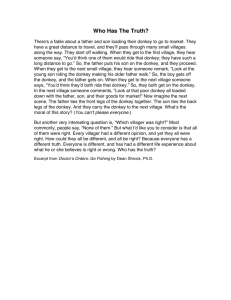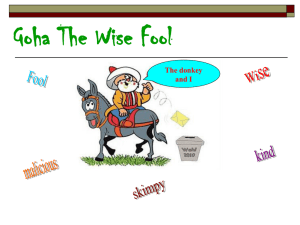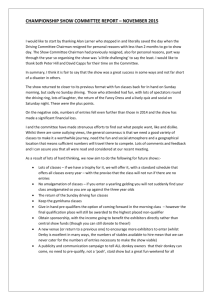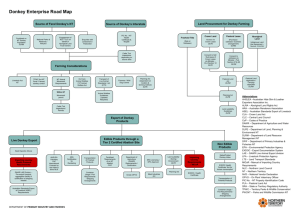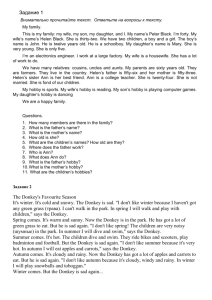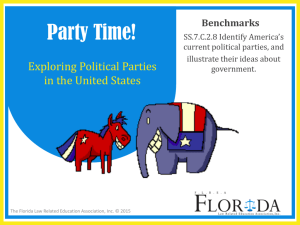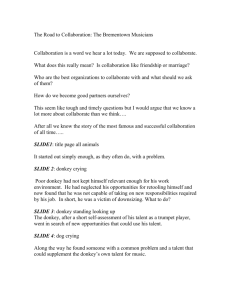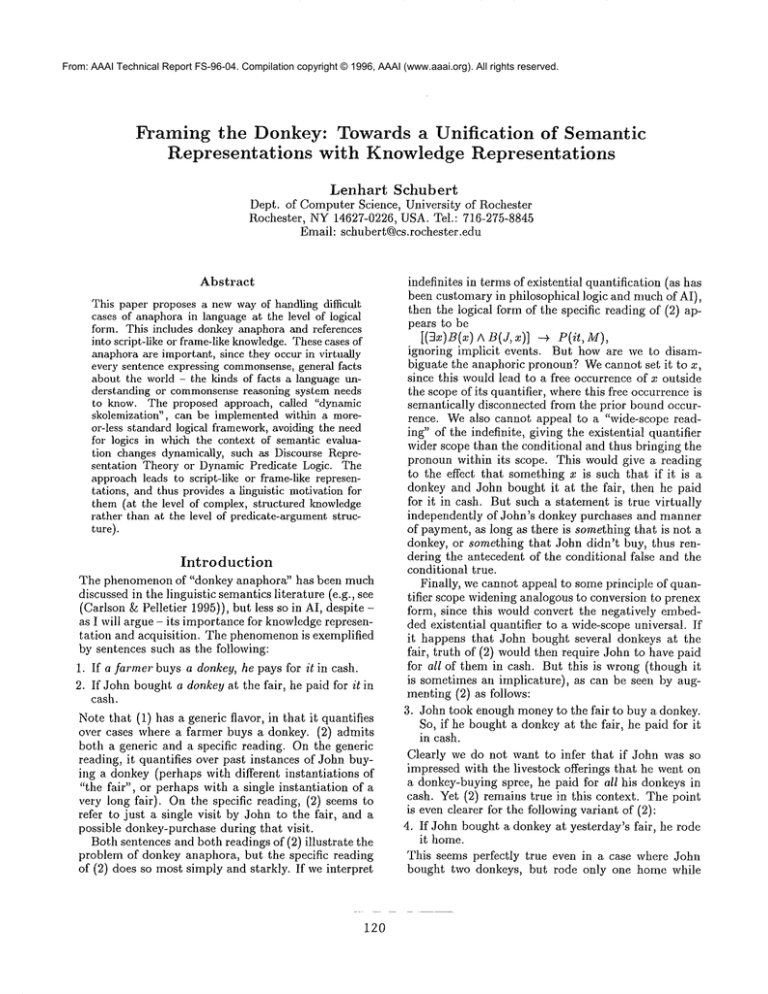
From: AAAI Technical Report FS-96-04. Compilation copyright © 1996, AAAI (www.aaai.org). All rights reserved.
Framing the Donkey: Towards a Unification
of Semantic
Representations
with Knowledge Representations
Lenhart
Schubert
Dept. of Computer Science, University of Rochester
Rochester, NY14627-0226, USA. Tel.: 716-275-8845
Emaih schubert@cs.rochester.edu
Abstract
This paper proposes a new way of handling difficult
cases of anaphora in language at the level of logical
form. This includes donkey anaphora and references
into script-like or frame-like knowledge.Thesecases of
anaphora are important, since they occur in virtually
every sentence expressing commonsense,
general facts
about the world - the kinds of facts a language understanding or commonsensereasoning system needs
to know. The proposed approach, called "dynamic
skolemization’, can be implemented within a moreor-less standard logical framework,avoiding the need
for logics in which the context of semantic evaluation changes dynamically, such as Discourse Representation Theory or DynamicPredicate Logic. The
approach leads to script-like or frame-like representations, and thus provides a linguistic motivation for
them (at the level of complex, structured knowledge
rather than at the level of predicate-argumentstructure).
Introduction
The phenomenon of "donkey anaphora" has been much
discussed in the linguistic semantics literature (e.g., see
(Carlson &: Pelletier 1995)), but less so in AI, despite
as I will argue - its importance for knowledgerepresentation and acquisition. The phenomenonis exemplified
by sentences such as the following:
1. If a farmer buys a donkey, he pays for it in cash.
2. If John bought a donkey at the fair, he paid for it in
cash.
Note that (1) has a generic flavor, in that it quantifies
over cases where a farmer buys a donkey. (2) admits
both a generic and a specific reading. On the generic
reading, it quantifies over past instances of John buying a donkey (perhaps with different instantiations of
"the fair", or perhaps with a single instantiation of a
very long fair). On the specific reading, (2) seems
refer to just a single visit by John to the fair, and a
possible donkey-purchase during that visit.
Both sentences and both readings of (2) illustrate the
problem of donkey anaphora, but the specific reading
of (2) does so most simply and starkly. If we interpret
120
indefinites in terms of existential quantification (as has
been customary in philosophical logic and muchof AI),
then the logical form of the specific reading of (2) appears to be
[(3x)B(x) A B(J, x)] -+ P(it, M),
ignoring implicit events. But how are we to disambiguate the anaphoric pronoun? Wecannot set it to x,
since this wouldlead to a free occurrence of x outside
the scope of its quantifier, wherethis free occurrenceis
semantically disconnected from the prior bound occurrence. Wealso cannot appeal to a "wide-scope reading" of the indefinite, giving the existential quantifier
wider scope than the conditional and thus bringing the
pronoun within its scope. This would give a reading
to the effect that something x is such that if it is a
donkey and John bought it at the fair, then he paid
for it in cash. But such a statement is true virtually
independently of John’s donkey purchases and manner
of payment, as long as there is something that is not a
donkey, or something that John didn’t buy, thus rendering the antecedent of the conditional false and the
conditional true.
Finally, we cannot appeal to some principle of quantifier scope widening analogous to conversion to prenex
form, since this would convert the negatively embedded existential quantifier to a wide-scope universal. If
it happens that John bought several donkeys at the
fair, truth of (2) would then require John to ha~e paid
for all of them in cash. But this is wrong (though it
is sometimes an implicature), as can be seen by augmenting (2) as follows:
3. John took enough moneyto the fair to buy a donkey.
So, if he bought a donkey at the fair, he paid for it
in cash.
Clearly we do not want to infer that if John was so
impressed with the livestock offerings that he went on
a donkey-buying spree, he paid for all his donkeys in
cash. Yet (2) remains true in this context. The point
is even clearer for the following variant of (2):
4. If John bought a donkey at yesterday’s fair, he rode
it home.
This seems perfectly true even in a case where John
bought two donkeys, but rode only one home while
leading the other. Another argument against the
scope-widening solution is that it plainly leads to incoherence for variants of (1) involving explicit generic
quantification, such as
5. If a farmer buys a donkey, he {usually/sometimes/
rarely} pays for it in cash.
Why, then, should the KR community care about
this problem? I claim that much of the knowledge
needed for commonsensereasoning is of this form. For
instance, the following are somegeneral facts that everyone presumably knows:
6. If a hungry predator encounters a smaller creature,
it maywell try to attack and eat it.
7. If a conspicuous action occurs within plain sight of
a person (in a normal state of alertness), the person
will notice it.
8. If an adult attacks a child, that is an extremely
wicked action.
9. If someone does something extremely wicked, and
others find out about it, they will want to punish
him severely.
10. If one enters an enclosure, one will then be inside it
(and outside it immediately before).
11. If you eat at a restaurant, you enter (it), get a table
to sit at, select a meal from a menu,place your order
with a waiter, etc.
The first five items are taken loosely from the encodings in (Schubert L: Hwang1989; Hwang& Schubert 1993a) of the knowledge needed to understand
some small fragments of a fairy tale (Little Red Riding Hood). Wefound that dozens of axioms of this
sort, encoded in EL (Episodic Logic, an NL-like representation) were typically required to enable the EPILOGsystem to make sense of a sentence in a story
(also represented in EL), i.e., to infer the "obvious"
causal, temporal, part-of, and other coherence relations. Of course, the claim that story understanding is
a knowledge-intensive activity is a truism in AI nowadays (thanks to the work of Roger Schank and his coworkers, and many others in the 70’s and 80’s), but
the present point concerns the particular form of the
required facts when stated in ordinary language. Evidently, all five sentences involve at least one instance
of donkey anaphora. (In the third sentence, the deictic
that is in effect a reference to an action whoseexistence
is implicit in the antecedent.)
The last sentence is intended to echo the kind of
knowledgeoften encoded in script-like representations.
Setting aside the role of you, the consequent clauses
clearly involve tacit or explicit references to the restaurant in question, and these references are again of the
"donkey" variety.
The need to convey huge numbers of mundane generalities to machines remains a frustrating bottleneck
in the effort to endow machines with ordinary understanding and commonsense. There are several possible ways of attacking the problem, the most direct
121
being the systematic hand-coding of the requisite facts
(Lenat 1995). However, this approach is very laborintensive, and the task would be greatly lightened if
the bulk of the necessary knowledgecould be conveyed
directly through language.
The problem of donkey anaphora presents a particularly formidable roadblock in this endeavor. There
are some proposed solutions that deal plausibly with
examples like (1-4), as indicated in the next section.
But in the first place, these solutions depend on adopting a logic with a quite radically altered, "dynamic"
semantics, and corresponding nonstandard inference
mechanisms.The possibility of translating into a more
conventional framework improves prospects for bridging the gap between work in linguistic semantics and
knowledge representation.
More importantly, I will
show in the next section that the dynamic semantics
approach encounters difficulties that would prevent its
broader use for "telling machines about the world".
In section 3, I will then develop the proposal I call
dynamic skolemization, showing howit deals both with
standard donkey anaphora and the more challenging
cases described in section 2. Dynamic skolemization
can be augmented so as to introduce new concepts
(predicates) that "summarize" the content of the formulas comprising the scope of the skolemized variables.
Whenthis is done, the representations becomes quite
concise, and strongly reminiscent of scripts and frames
in AI.
In section 4 I discuss somefurther issues in the application of dynamicskolemiztion, and possible limitations of the approach. In the final section I reiterate
my conclusions.
Earlier
Solutions:
Dynamic
Semantics
The difficulties
posed by donkey anaphora have
spurred new developments in the logical anMysis and
representation of ordinary language. Sentence (1), repeated here as (12), will serve to illustrate two wellknownapproaches very briefly:
12(a) If a farmer buys a donkey, he pays for it in cash
x y
F(x)
Z
W
P(z,w)
D(y)
B(x,y)
g~x
w=y
(b)
(c) .,y : F(.),D(v), B(.,y))
P(z,w),z
(z, w
= x,w =
13. [(3x, y)F(x)/~ D(y) A y)] - -+ P(x,
Perhaps the best-known approach to anaphora is that
of (Kamp 1981) and (Heim 1982), known as DRT.
representation of (2a), repeated here as (12a), would
a Discourse Representation Structure (DRS) as shown
in (12b). This DRScontains a conditional whose antecedent and consequent are again DRS’s. The indefinites a farmer and a donkey are represented as variables called "discourse referents", comprising the syntactically separate "universe" of the antecedent DRS.
Corresponding "conditions" F(x) and D(y) appropriately constrain them in the antecedent DRS.The treatment of the definites ill the consequent DRSis analogous, and the anaphoric references are resolved by
the equations in the consequent DRS. An alternative,
nonpictorial syntax could be as illustrated in (12c).
What is crucial here is the semantics, in particular
the "dynamic" way in which discourse referents are
added to the domainof a partial assignment function in
the course of semantically evaluating ~ DRS.Roughly
speaking, a conditional DRSlike (12b) is taken to
true relative to a model and a partial assignment if
every way of making the antecedent true by adding its
discourse referents (here, x and y) to the domain
the assignment can be extended to a way of making
the consequent true by adding its discourse referents
(here, z and w) to the domain of the assignment.
Clearly, then, the way DRTtreats the anaphoric pronouns in the consequent of a conditional is both syntactically and semantically dependent on the presence of
coreferring discourse referents in the antecedent. Syntactically, the translations of the pronouns need to be
equated to "accessible" referents (such as those in the
antecedent, or ill the universe of an embedding DRS),
and semantically the equations succeed in making the
desired connection because of the way partial assignment functions get extended in the antecedent, and the
way this extension is "carried forward" to the consequent.
A disadvantage of DRTas a meaning representation is that it requires a mapping from surface linguistic form to logical form that is hard to reconcile
with a compositional semantics. DPL (Groenendijk
& Stokhof 1991) provides a compositional alternative.
DPLwould assign (12) the logical form shown in (13).
Note that in DPLwe can actually substitute the quantified variables x and y for the anaphoric pronouns,
much as we were tempted to do - but couldn’t make
formal sense of- in the case of it in (2). The way DPL
makes sense of (13) is by treating formulas muchlike
computer programs, where variables are assigned values in earlier subformulas, and these vMuespersist to
later subformulas. In particular, an existential formula
(3x)O is thought of as denoting nondeterministic as signment to x, followed by a test ~. Truth corresponds
to "executability" (for someinitial values of the variables and some nondeterministic choices during execution). Technically, this is formalized in terms of statechange semantics, where a state is a (total) variable
assignment; i.e., the semantic value of (3x)(~ relative
to a modelconsists of the pairs of states such that the
formula can (nondeterministically) transform one into
the other. For a conditional (~ -+ ~, successful exe-
122
cution (truth) requires that for every way of executing
¯ , the resultant state allows execution of @.
Again, the dynamic change in the context of evaluation induced by the prior materiM is apparent, as is
the need for "accessible" prior referents. Another significant point to note is that both approaches lead to a
universal interpretation of indefinites in the antecedent
of a. conditional. In DRT,this is because of the iteration over all ways of making the antecedent true (in
the present example, all ways of picking a farmer and
a donkey such that the farmer buys the donkey). Similarly, in DPLthis is because of the iteration over successful executions of the antecedent. So this semantics
is somewhat appropriate for (12) but hardly for the
specific reading of (2). However, one could define
"specific conditional" within DRTor DPLthat does
justice to intuitions about (2). EL, mentioned above,
would assign much the same logical form as DPLto
(12) (neglecting events), but would employ a distinctive "generic conditional" to obtain a quasi-universal
reading. For the material conditional, EL’s particular
brand of DRT-like dynamic semantics would give the
desired specific reading for (2).
The reliance of these theories on the presence of accessible referents for interpreting anaphora can be a
serious handicap. This is apparent for passages where
"dependent entities" are introduced in one sentence,
and then referenced in another, as in
14. There were several instances at the fair where a
farmer bought a donkey. In each instance, the
farmer paid for the donkey in cash.
The dynamic semantics approaches provide no easy
way to logically represent the referential definites in
the second sentence so that they refer to the appropriate farmer and donkey in each of the instances under
discussion. This is apparent if we write downa DPLlike or EL-like logical form for these sentences (enriching the basic syntax slightly so as to allow restricted
quantifiers and someset-theoretic constructs):
15. (a) (3S:set-of-instances(S))
(re: e ~ S)
(3~: F(~))(3yD(V))B(~, y,
(b) (re: e ¯ S)(3e’: e’
(The z: F(z))(The w: D(w))P(z,w,e’).
This interprets the "instances" in (13) as donkeypurchases by farmers~ and accordingly introduces a
Davidson-like event variable into B ("buys") and likewise into P ("pays in cash for"). While I do not regard this approach to event representation adequate
(see (Hwang~ Schubert 1993b)) it will do for present
purposes.
Note, first of all, that the referentiM connection between the bound occurrence of S at the beginning
and the free occurrence later on will be made successfully by the dynamic semantics approaches mentioned. However,the same is not true of the definites
(The z : F(z)) and (The w : D(w)). Substituting the
farmer-variable x from the first sentence for z, and the
donkey-variable y for w, simply does not lead to a coherent result in any of the theories, since (3x : F(x))
and (3y : D(y)) lie within the scope of a universal
quantifier. Intuitively, the first sentence posits various
values of x and y depending on the choice of e E S,
and in the second sentence z and w should refer to
these values as a function of e, but no such function is
available.
The problem is that the desired referents are too
deeply embeddedin the prior discourse, so that they
cannot do the required context-setting for interpreting
the anaphoric descriptions. In fact, the only way we
appear to have of solving the reference problem is to
reformulate the second sentence so that it repeats the
content of the first sentence antecedently, makingthe
required referents directly accessible:
16(a) In each instance, if a farmer bought a donkey, the
farmer paid for the donkey in cash.
(b) (Ve:e E S) [(3x: F(x))(3y: D(y))B(x,y,e)]
-+
(3e’: e’ ~ e)P(x, y, e’)
However, besides being cumbersome and ad hoc, this
importation of material ought to be redundant. After
all, the discourse prior to (16a) already characterized
the instances in question as instances in which a farmer
buys a donkey, so why should we have re-specify this
property?
This is not the worst case. There are familiar kinds
of reference where the required antecedent material is
not merely submerged in the prior discourse, but hidden in the tacit knowledge of the speaker and hearer.
The following is an example:
17(a) John dined at Mario’s. He left a big tip for the
waiter.
(b) (3e)D(J,M,e). (3x: T(x))(3e’ : e’ E_
(They: W(y))L(J,x,y,e’)
Any of the dynamic semantics approaches would now
require retrieving and instanti&ting a "dining out" scenario, at least in part, and incorporating this antecedently into the representation of the second sentence. Only then would we be able to resolve the definite description (The y: W(y)) to the appropriate referent, i.e., the waiter who served John. This approach
would be laborious and hard to systematize, keeping
in mind that stored scenarios could be quite complex,
and that multiple scenarios could be relevant to a single sentence (e.g., "At the business dinner at Mario’s,
the waiter spilled coffee on the CEOjust when he was
about to put up some pie-charts"). These are just the
sorts of problems that hampered full exploitation of
"scripts" in story-understanding research in the 70’s
and 80’s.
Mygoal here is to provide a straightforward and
concise method of interpreting sentences involving
anaphora as in (16) and (17), as well as the more
nocuous cases of donkey anaphora. The idea is to make
123
available Skolem functions (constants, in the simplest
cases) for establishing referential connections. For instance, in the case of (17) we want to make avMlable
a "waiter function" that picks out the waiter of any
dining-out event, as a function of that event. In the
following I develop such an approach, beginning with
simple cases of (non-donkey) anaphora.
Dynamic
Skolemization
Skolem constants
Let’s begin with a very simple example of crosssentential anaphora, the sort that invites the use of
Skolem constants - and has been dealt with in that
way in countless natural-language systems:
18(a) John bought a donkey. He paid for it in cash.
(b) (3z: D(z))(3e)B(J, x, e). (3e’)P(J,
(c) D(A) A B(J, A, E). P(J, A,
(185) shows the preliminary logical form of (18a)
(again with Davidsonian event arguments). In (18c),
the variable x for the newly introduced donkey has
been skolemized to A and the variable e for the newly
introduced buying event has been skolemized to E.
The anaphoric pronoun has also been replaced by A,
unproblematically making the cross-sentential connection. Note that (as in some previous examples) there
is also an implicit relation between the paying event
and the buying event, i.e, the paying is understood
to be part of the buying. Various theories have been
proposed for deriving this sort of connection systematically (e.g., (Webber1988; Hwang&~ Schubert 1992;
Lascarides et al. 1992)). By whatever means the connection is derived, the skolemization of event variables
~.
facilitates its representation, e.g., as E _ E
Weshould note in passing that skolemization is not
a logically sound transformation. Rather, it amounts
to a logical strengthening, since predicating constraints
on a constant will filter out somepossible models. But
the stregthening is trivial in the sense that it is guaranteed to preserve satisfiability,
and that no new sentences are entailed, other than some that involve the
Skolem constant. (See the "conservative extension"
theorem below. This is whyskolemization is legitimate
in refutation proofs, such as resolution proofs.)
If one now considers a conditional sentence like (2)
(repeated here as (19a)), one feels intuitively that
an&phoricconnection is madejust as in (18a), the nonconditional case.
19(a) If John bought a donkey at the fair, he paid for it
in cash.
(b) [(3x)D(x) B(J, x)] -+ P(J, it)
(c) [DCA)A B(J, A)] -~ P(J, A).
One conceptualizes the situation of John buying a donkey, and in doing so, establishes some conceptual token
for the donkey. This token is then available for reference, whether the context-setting sentence supplies a
fact or a proviso.
Of course, tile discourse referents of DRTand the
existential variables of DPLprovide just such tokens,
but I have argued that they do so only very locally
and transiently. Skolem constants and functions could
provide a simple, "heavy-duty" alternative, but seem
to fail us here. If we assign to (19a) the preliminary
logical form (19b) (neglecting events for simplicity)
and then attempt to skolemize and resolve the referent
as earlier in (18c), the result (19c) is patently defective. This is apparent from the fact that (19c) is the
skolemized form of (Jx)[D(x)AB(J, x) -4 z)], i.e.,
"There is a thing x such that if it is a donkey and John
bought it, then he paid for it in cash"; but this is trivially true if we can find any x that is not a donkey
or was not bought by John, rendering the antecedent
false.
However,it is interesting to note that (19c) fails
a representation of (19a) by being too weak, rather
than too strong. Given (19a) and given that John
bought a donkey, it should follow that there is a donkey that John bought, and paid for in cash. But if we
replace (19a) as a premise in this argument by (19c),
the conclusion no longer follows. This is because the
existence of a donkey that John bought fails to entail
D(A) A B(J, A), tile antecedent of (19c).
This suggests a simple remedy: we supplement the
skolemization ill (19C) with the following stipulation:
20. (3x: D(x))B(J,x)
-+ D(A) A
I will use the term dynamic skolemization for the two
steps of (i) skolemizingan existential variable, and (ii)
stipulating a supplementary condition like (20) above,
relating the unskolemized existential formula to its
skolemized form. (This is stated more formally, and
generalized, below.) I will also refer to the supplementary condition itself as a "Skolemconditional".
Given (20), falsity of D(A) A B(J,A) implies that
John didn’t buy a dunkey. So D(A) A B(J, canno
longer be trivially false, and (19c) trivially true, as
result of A not being a donkey or John not having
bought it. Someadditional points are worth noting.
First, the Skolem conditional can be turned into a biconditional, by existential generalization. This makes
it natural to think of (20) as a partial definition of the
newly introduced constant A. As such it provides a
conservative extension of any theory framed in a vocabulary exclusive of A, as shownlater.
Second, when we resolve the pronoun in (19a,b)
the constant A, introduced through dynamic skolemization, the resultant reading is non-universal. To obtain a past-habitual reading of (19a), a generic or habitual quantifier (arguably, over events) would have
be introduced into the logical form (19b). Examples
this sort will be seen later.
A third, related point concerns the logical consequences of readings based on dynamic skolemization.
Suppose we are told after (19a) that John did buy
a donkey (within the relevant time frame), namely
Archie (AI):
124
D(A’) A B(J,A’).
It does not follow that John paid for Archie in cash.
This is because it does not follow that A/ -= A. If we
want these consequences, we could add the following
(conditional) uniqueness implicature to our interpreta1tion of (19a):
[(3x: D(x))B(J,x)] -+ iS!x: D(x))B(J,
An alternative would be to regard the report of John’s
purchase of Archie as implicating the uniqueness of this
donkey-purchase. In fact, both implicatures may well
be present.
Abstracting from the above example, we can define dynamic skolemization as follows, for an existential sentence that occurs outside the scope of all other
quantifiers:
21. Given an occurrence of a (closed) sentence
form (ix : ~)~ in the provisional logical form
of an English sentence being interpreted,
(a) assert the Skolemconditional
(3x : ~)~ -+ (~Cl~ A ~Cl~,
where C is a new constant;
(b) replace the original occurrence of (3x : (D)~
by the consequent of the above implication.
The notation a)c/~ stands for the result of substituting
C for all free occurrences of x in ft.2 The "provisional
logical form" of a sentence refers to the logical form we
would obtain before determining referents of pronouns
and definites, but after analyzing phrase structure, applying rules of logical-form composition corresponding
to phrase structure rules (grounding these in a lexicon
that supplies logical translations of lexical items), and
scoping quantifiers. Of course, phrase structure, lexical
semantics, and quantifier scope are all sources of ambiguity, so an actual analysis sytem would in general
have to entertain multiple provisional logical forms for
a given (partial) sentence. The different reference possibilities corresponding to these different logical forms
may lead to more or less coherent interpretations, and
in this w~, maywell influence the ultimate resolution
of the various types of ambiguity.
Let us note some properties of dynamic skolemization, beginning with the following simple
Theorem. The Skolem conditional (21a) provides
~I take such an implicagure to be present in manycontexts, and to be the result of the hearer’s assumptionthat
ff the speaker thought there might have been multiple instances of the indefinite, and such instances are relevant to
the purposes of the exchange, then he wouldhave madethis
possibility explicit. This is analogousto Gricean"quantity
scale implicatures" in sentences such as "Some/Moststudents passed the exam", or "If some/moststudents passed
the exam, John will be pleased", where the speaker seems
to assumethat not all students passed the exam.
2I use the particular variable x and constant C here for
readability, but these are of course arbitrary.
conservative extension of any theory fi’amed in a vocabulary exclusive of the new Skolem constant C.
What this means is that no new sentences follow from
the theory together with the definition, other than ones
involving the defined term C. The theorem is easily
proved by considering any formula ~5 not involving C
that is entailed by a given theory T (not involving C)
together with the Skolem conditional. For any model
Ad of theory T, let 3d’ = A4 if the antecedent of the
Skolemconditional is false in 3/l; otherwise let M’differ from .A4 only in assigning a value to C that makes
the consequent of the Skolem conditional true. Then
jr4’ is a model of 7- together with the Skolem conditional, and so by assumption satisfies ~. But jr4 and
Ad’ agree on O, hence Adsatisfies O. Thus 7- entails #9.
I leave the generalization of the theorem (and proof)
for the case of Skolemfunctions (below) to the reader.
Another property that (21) ought to satisfy is that
it should give the expected result in simple declarative
contexts - keeping in mind that it was motivated by
existential sentences within conditional antecedents. It
is easy to see that it does. For instance, consider (once
again) (18a). First, note that the skolemization specifled by (21b) yields the sentence D(A)A B(J, A) (modulo the choice of arbitrary new constant) as previously
specified in (18c). But since this sentence occurs at the
top level of the text being interpreted, it is asserted. As
such it entails the Skolemconditional (previously given
as (20)), since it coincides with the consequent. Hence
the Skolem conditional is redundant. In other words,
in the case of simple declaratives (21) just describes
ordinary skolemization of top-level existentials.
Skolem functions,
concept
definitions
The generalization of dynamic skolemization (21)
existential formulas containing free variables (i.e.,
embedded within the scope of other quantifiers) is
straightforward:
22. Given an occurrence of a formula (3y : O)q~,
containing free variables Zl, ..., Xm,in the provisional logical form of an English sentence
being interpreted,
(a) assert the Skolem conditional
(c) Assert:
(Vx)[(By D(y))B(z, y) ~ D(f (x)) A B f( x))]
Subst.:
(gx: F(x) A D(I(x)) A B(x, f(x)))
Note the resolution of the anaphoric pronoun in (23c).
The reading this encodes is non-universal for donkeys,
i.e., any one farmer purchasing multiple donkeys need
only have paid for one in cash. I believe this is correct,
based on examples analogous to (a) and (4), despite
the frequently present universal implicature, s For example, an analog of (4)
24. Every farmer who bought a donkey rode it home,
which seems true even if the farmers involved rode only
one donkey each.
It is clear that repeated application of (22) to
formula with multiple existential quantifiers, (3yl
¢l)...(Syn : (~,)~ will be equivalent to simultaneous
skolemization of the Yi to fl, ..., fn. I will henceforth
freely apply it in this way. The following is an interesting variant of (1), illustrating the case n = 2; (25b)
is the Skolem conditional, and (25c) the logical form
of (25a) after substitution:
25(a) Whenever a farmer bought a donkey, he paid for
it in cash.
(b) (Ve)[(3x F(x))(3y : D(y))B(z, y,
F(f(e) ) A D(g(e) ) A B(f(e), e)]
(c) (ge)[F(f(e)) A D(g(e)) g(e), e) (3e’) P(f(e), g(e), e’)]
The whenever-clause calls for universal event quantification,
and this leads to the introduction of a
farmer-function f and donkey-function g on events. In
this case, we obtain a reading that effectively quantifies universally over farmers and donkeys, assuming
that in distinct action predications such as B(x, y,e),
B(x’, y~, e’), e and e’ cannot be the same buying-event
unless z and y are the same as x’ and y’ respectively.
This seems intuitively correct.
A simple illustration
is provided by the following
type of quantified donkey sentence, often used as central examplein the literature; (we neglect events):
There remains a certain inelegance in these examples of dynamic skolemization from a practical computational perspective, in that we are repeating variants
of the original existential formula, (3yl : ~l)...(qy,
¯ ,~)~, three times: twice in the Skolemconditional (in
the antecedent and consequent) and once in the logical form of the given text. I will therefore introduce
a space-saving notation, called concept definition that
avoids redundancy.
Before defining the notation formally, the idea is just
this: when we encounter a wff (3yl)...(3y~)~ that is
be skolemized, we first define a new predicate that is
simultaneously equivalent to (i) this wiT, for all values
of the free variables (those not bound by the (Sy~)),
and (ii) the skolemized version of the a4f. Wethen
23(a) Every farmer who bought a donkey paid for it in
cash.
(b) (Vx: F(x) A (By: D(y))B(x, y)) P(x,it)
aI believe that a reasonableaccountof the universal implicature is possible, in terms of interpretive strategies in
the face of violated uniquenessimplicatures.
(vxo...(vxm)[(By
eP.t(~:,
......,,,)Iv A~~(~;,..... ~:,,,)lv],
where f is a new m-place function symbol;
(b) replace the original occurrence of (By :
by the consequent of the above implication.
125
substitute the newly defined predicate into the source
text. Formally, the concept definition schemais this:
26. For 7r a new m-place predicate constant,
fl,...,
fn new m-place function constants,
and 4) a formula possibly containing free
occurrences of variables Xl,...,xm
and
Yl,.--, Y, (and no others),
(Def 7r (Xl,..., xm) (fl .... , f,~) ~]/y__)
abbreviates (with underlining indicating
vectors)
I will assume that generally quantifies over dining-atrestaurant episodes here, binding an episodic variable:
(Gen e :0x: P(x))(3y : n0))D(x,
(Be, : e~ I- e A starts(el, e))Enter(2,#, A
(3e2
: e2Ee
(3e E e A
Get-seated(A
e2)
Seleet(
, e3)
Tell-order(2, w, e4) A
¯ ’’
...,
xl,..., xm are tlle variables of the Def-schema,fl, --., fn
are the roles (role functions, Skolem functions), and
¢~]/y is the body of the definition. Note that in this
body we are using function symbols (without arguments) in place of variables, so that the result will not
be a well-formed formula. This avoids having to repeat
the variables xl, ..., xm on which each role depends.
Applying the Def-schemato (25) as described above,
we get a more concise and transparent representation of the dynamic skolemization (now formulated
as a concept definition, (27a)) and the resultant logical form, (27b); FBDis the newly defined concept
(mnemonic for "farmer buys donkey"):
27(a) (Def FBD(e) (f,g) F(f) A D(g) A
(b) (re) FBD(e) --+ (3e’)P(f(e),g(e),
Weare now well-equipped to return to the farmers
at the fair, and Mario’s restaurant. Looking back at
(1ha), note that we will first skolemize S, the set
instances mentioned, to some new constant (but I will
retain S here). The next existential sentence encountered is (3x : F(x))(3y : D(y))B(x,y,e).
Hence we
get the definition
(Def FBD(e) (f, g) F(f) A D(g) A B(I,
Substituting the defined concept in the provisional logical form (15a), we obtain (28a); we can noweasily
solve the references in (15b) to f(e) and g(e), as shown
in (28b):
28(a) (Ve:e S)FBD(e).
(b) (Ve:e e S)(3e’ : e’ _E e)P(f(e),g(e),e’).
To deal with the exampleof Mario’s restaurant, (17),
we naturally need to presuppose some prior knowledge
of "what happens when" a person dines out. While
people are unlikely to first acquire this information in
the form of a tidy verbal package, it would help with
knowledgebootstrapping if this were possible for computers. So suppose we tell our NLPsystem something
like the following:
Generally, when a person dines at a restaurant,
s/he enters the restaurant, gets seated at a table,
selects a meal from a menu, tells the order to a
waiter, etc.
126
)
Note that the first line of this expression comprises
the restrictor of the Gen quantifier. The symbols with
carets are an ad hoc abbreviation for anaphoric terms,
used for readability. For instance, Enter(~.,!~, el) abbreviates
(The z: R(z))Enter(s/he,z,
i.e., s/he enters the restaurant; the particular symbols
used, such as a? and ~), are intended to suggest to the
reader the expected referents of these terms.
The first existential sentence encountered is the restrictor of the Gen quantifier. Thus we apply dynamic
skolemization and concept definition to it:
(Def PDR(e) (f, g) P(f) ) A D(f , g, e)
Havingsubstituted the defined predicate in the restrictot, and knowingthat x is nowf(e) and y is g(e),
can also resolve 2 and ~ to f(e) and g(e) respectively
in the matrix of the Gen construct. Next we apply dynamic skolemization and concept definition to the matrix. Here I allow myself a slight liberty, skolenfizing all
of the conjoined existential sentences at once (processing them in succession would yield multiple definitions
rather than a single one, but would otherwise be equivalent):
(Def PDRsteps(e) (fl, f2, f3, h, f4,...)
fl E e A starts(£, e) A Enter(f, g, fl) A
IV(h) A f4 E e A f3 -4 f4 A Tell-order(f, f4)
’’’
)
Substituting in the matrix of Gen, we then obtain
( Gen e :PDR(e))PDRsteps(e).
Having accommodated the background knowledge in
this way, we are now ready to interpret the definite
description the waiter in (17), repeated here as (29a).
The result is (29b), and after further skolemization,
29(a) John dined at Mario’s. He left a big tip for the
waiter.
(b) D(J, M, E).
(3x: T(x))(3e : E)L(J, x, h(E)e).
(c) D(J, M, E). T(C) A E’ r- E A L(J, C, h(E), E’).
There is still a hidden ambiguity, however. As far
as the stored background knowledge is concerned, the
agent of E is f(E) and the restaurant is g(E). To link
these to John and Mario’s respectively, we again need
to invoke a "uniqueness of roles" assumption concerning dining-out events:
(Ve) (Vx, y, x’, y’)D(x, y, e) A D(x’, y~, e)
x=x’Ay=y’.
Again, this is an intuitively
reasonable assumption.
Scripts,
Frames
and Knowledge
Bootstrapping
The reader has probably noticed a close resemblance
between the above encodings of the farmers-at-the-fair
and dining-at-Mario’s examples on the one hand, and
scripts and frames as understood in AI (e.g., (Schank
& Abelson 1977; Minsky 1975)) on the other. For instance, Minsky suggests that a person entering an office retrieves and instantiates an office frame featuring
slots for the expected parts and furnishings (floor, ceiling, walls, door, desk, chair, etc.). These slots quickly
becomebound to perceived parts and furnishings, and
the knowledgeassociated with them helps to guide further perception and action. Nowthis is just the sort of
structured representation we would obtain by skolemizing a description of the form, "An office generally has
a floor, a ceiling, four walls, a door, a desk, etc., with
such-and-such properties and related in such-and-such
ways...". Assuminga provisional logical form like
(aen x: Office(x))[(3yl Floo,tw) .. . ],
we would define of a concept such as Office-interior(x)
corresponding to the body of the Gen-formula, with
roles (Skolem functions) that pick out the parts and
furnishings of the office. It would then be straightforward to interpret the definites in general and particular
sentences like
30. An office belonging to a professor often has piles of
books and papers on the desk.
31. Mary went into her office and sat downat the desk.
Note that the Gem-formulafor an office does not involve any existential quantifiers in the restrictor, and
so does not give rise to a concept definition for the
restrictor (in contrast with the examples of the farmers at the fair and Mario’s restaurant). Thus the formula supplies information about the pre-existing concept of an office, rather than about newly introduced
episodic notion such as that of dining at a restaurant.
This is typically how frames have been employed in
knowledge-based systems, i.e., they are used to supply information about familiar, usually non-episodic
concepts such as that of an office, a wage earner, a
particular product, etc., expressible with a lexical or
compound noun.
In the case of general episodic knowledge, the tie-in
with scripts is by now obvious. The dining-out example was of course intended as a parallel to Schank and
Abelson’s (1977) restaurant script. While their script
is not formally interpreted, the nameof the script can
be viewed as a defined concept similar to PDRabove;
further, it involves roles for the participating entities
that are clearly analogous to some of the skolemized
roles in the definitions
of PDRand PDRsteps, and
it involves steps that are analogous to the skolemized
127
subepisodes in PDRsteps. An interesting difference is
that it is not possible to access the roles in a script
"from the outside", as seems to be required for representing general or particular sentences such as
31. Whena person dines at a fancy restaurant,
the waiter directly, not at a cash register.
s/he pays
32. WhenMary dined at Mario’s, the waiter turned out
to be an an ex-classmate of hers.
For (31), a traditional script-based approach would
have to create a variant script for fancy dining, as
a context in which to place the new fact (assuming
that the pre-existing restaurant script is noncommittal about how the bill is paid). This could be done
in some ad hoe way by modifying a copy of the regular script, or directly inserting an alternative track into
that script. In the approach based on dynamic skolemization, we would automatically create a separate concept of dining at a fancy restaurant, and, recognizing
that dining at a fancy restaurant entails dining at a
restaurmlt, make use of the role functions in the PDR
and PDRsteps definitions to pick out the waiter (and
the implicitly referenced bill). For (32), the traditional
approach would expand out an instance of the restaurant script, thus gaining access to the waiter in that
script instance. In the approach based on dynamic
skolemization, it is sufficient to recognize Mary’s dining at Mario’s as an instance of a person dining at
a restaurant (hence instantiating PDR); this immediately makes available the role functions in PDRsteps
(as was illustrated for 29a).
It has been knownfor a long time that frame slots involve Skolem-like functions, logically speaking (Hayes
1979). Furthermore, role-functions have been proposed
in the planning literature for picking out steps in goaloriented courses of action (e.g., Kautz 1991). However, the representational devices employedin scripts,
frames and plans were conceived on purely computational and introspective grounds, with no formal links
to the syntax/semantics interface. So it seems auspicious that considerations arising from problems in
linguistic anaphora lead directly to script/frame-like
representations, and in doing so also provide solutions
to sometraditionally difficult reference problems.
Schank and his collaborators were very interested in
the problem of learning scripts by generalization from
particular narratives containing repetitive patterns of
events (Schank 1982). While this type of generalization
learning is undoubtedly of crucial importance for AI,
the present work clears some obstacles from a more direct path to the acquisition of such knowledge, namely
explicit description of the general patterns in ordinary
language. Lenat (1995), as mentioned earlier, has already mounted a large-scale effort to encode general
knowledgedirectly in a frame-like representation. But
this has dependedso far on familiarizing the contributors to this effort with the internal representation, and
entrusting to their intuitions the correct formulation
of commonsensefacts in this representation. Such an
effort wouldsurely benefit from an effective linguistic
input channel. Language is the shared mediumfor the
exchange of commonsense human knowledge, and as
such would provide a much faster, much more natural means for knowledgebootstrapping; as well, if the
mappingfrom the internally stored information to language were straightforward and systematic, browsing
and verifying the stored knowledge, and any inferences
drawn from it, would become much easier.
Further
Issues
A variety of issues remain concerning the scope and
details of dynamic skolemization. Most require further
research, but I want to at least touch briefly on some
of them.
First, a question of interest in linguistic semantics is
how the proposed interpretation
of donkey sentences
fares with respect to the "proportion problem" (e.g.,
(Kadmon1987)). For example, consider the following
sentence:
33. In most instances, if a farmer owns a donkey,
he is poor.
Supposethat the facts relevant to (33) are that 99 out
of 100 farmers ownjust one donkey and are poor, while
one out of 100 farmers owns 100 donkeys and is not
poor. Then (33) seems true on its preferred reading,
despite the fact that less than half of all farmer-owned
donkeys are owned by poor farmers. The question here
is howwe individuate instances of farmers owningdonkeys. If we treat instances as Davidsonian events (i.e.,
as tacit arguments of verbs, in this case owns), then
each instance of a particular farmer owning a particular donkeyis distinct, and (33) will turn out false.
One option here is to equate instances with farmers,
yielding the desired reading that most farmers who
own a donkey are poor. A disadvantage of this approach is that it calls for a rather complex mapping
from surface form to logical form, allowing quantifiacational binding of an indefinite sentential subject (
farmer) by a frequency adverbial (in most instances).
Be that as it may, dynamic skolemization will not complicate matters. If in the provisional logical form the
farmer-variable is bound by most rather than by 3,
then the only Skolem function introduced will be one
that picks out a donkey corresponding to a given donkey owner. As it happens, this function is not needed
in the matrix clause of (33), since this contains no reference to the donkey. If it contained such a reference,
the Skolem function would unproblematically resolve
it.
To me a more attractive option is to treat instances
as events (more generally, situations/ eventualities/
episodes), but not as Davidsonian ones. Weregard
events as being determined not just by atomic predications, but also by more complex formulas such as
(By : D(y))O(x, as i n Situ ation Semantics (Bar wise
128
& Perry 1983) or Episodic Logic (Hwang ~ Schubert
1993b). Then the ownership events over which (33)
quantifies need no longer be so "fine-grained" that each
donkey determines a distinct event. This can account
for the preferred reading. However, the details would
require a digression into SS or EL. Suffice it to say that
dynamic skolemization would still work in such a setting, with somecomplications arising from the relative
scopes of existential quantifiers and the operators that
link formulas to events (~ in SS, ** and * in EL).
A second issue concerns reference to disjunctions of
indefinites, as in
34. If a farmer buys a donkey or a mule, he pays for it
in cash.
Here unmodified application of dynamic skolemization
will yield two Skolemfunctions, one for each disjunct.
Yet we want to cover both alternatives with the referential pronoun (it). (We should note that the same
problem arises in the dynamic semantics approaches.)
One possible solution is to invoke the logical equivalence
(3x)~ V (3y)~ ++ (3x)(¢ V ~[:c/y])
before skolemizing. Or, placing the burden on the mapping from surface form to logical form, we could allow
for an interpretation of a disjunction (NP1 or NP2)
indefinite noun phrases as one of
(~x[NP
i (,~c) V NP~(x)]),
(3x[[x = NPl] V [x = NP~]]),
depending on whether the indefinite NPs are interpreted as predicates or as quantified terms. The angle brackets indicate an unscoped existential quantifier, and NP~denotes the logical translation of NPi.
(In the second version, this again contains an unscoped 3-quantifier.) Unscopedquantifiers are eventually assigned sentential scope within the complete logical translation of a clause. I would argue that such a
shared-variable interpretation is even possible (though
dispreferred) for conjunctions. Witness, for instance,
the sentence
35. Our northern neighbor, and the best friend this
country has, is currently quarreling with us over fishing rights.
Here we are referring to some x (e.g., Canada, from
USperspective) such that x is our northern neighbor
and is the best friend this country has.
A third issue concerns reference to indefinites in
negated contexts, as in the following example:
36(a) John didn’t buy a donkey and pay for it in cash.
(b) --[(3z D(x))B(J, x) A P(d, it)
Let us take (36b) as the provisional logical form
(36a), where the existential quantifier has narrow scope
relative
to the conjunction. If we now apply the
dynamic skolemization schema (21), we obtain the
skolemizedversion -~( D( A ) A B( J, A) A P ( J, it) With
it resolved to A, we have -~(D(A) B(J, A) A P(J , A))
Does this (along with the Skolem conditional) capture the intuitive meaningof (36)? Not quite. Rather,
it expresses the (weaker) proposition that if John
bought just one donkey, then he didn’t pay for it
in cash. For, if John bought a donkey, then by the
Skolem conditional, D(A) A B(J, hol ds, and hence
from -~(D(A) A B(J, A) A P(J, A)), -~P(J, holds, i.e .,
John did not pay in cash for the one donkey he bought.
This is a consequence we want, but we also want the
stronger consequence that John did not pay in cash for
any donkey he bought, no matter how many he bought.
Wecan obtain a correct skolemized version of (36a)
by treating the existential quantifier in (36b) as having wider scope than the conjunction. (I deliberately
left the scopes in (36b) ambiguous.) For then we
resolve the anaphoric pronoun, setting it to x, before skolemizing. If we nowskolemize, we still obtain
-~(D(A) A B(J, A) A P(J, But t he S kolem conditional now states that if John bought a donkey and
paid for it in cash, then A is such a donkey. Since
the skolemized sentence denies that A is a donkey that
John bought and paid for in cash, it follows that there
is no such donkey.
However,if the point of skolemization is to facilitate
the interpretation of anaphoric expressions, then we
need not have skolemized at all here. The situation is
just as if the sentence had been
37. John didn’t buy every donkey (in sight) and pay for
it in cash,
where there are no indefinites to skolemize. Here, too,
correct interpretation
of the pronoun appears to cM1
for wide-scopingof the quantifier (in this case V rather
than 3), so that the pronoun can be identified with
the quantified variable. Myconjecture is that dynamic
skolemization is inappropriate in negated contexts, and
is not needed for representing reference relations confined to such contexts.
But what about apparent cases of external reference
into negated contexts, as in
38. John didn’t buy a DONKEY.
It was a mule. ?
The result of dynamically skolemizing the indefinite in
the negated context would again be unsatisfactory. In
particular, it would fail to capture the entailment that
John bought a mule. This is to be expected, since
the interpretation of (38) depends upon a presupposition, mediated by the indicated stress on A DONKI~Y,
that John did buy SOMEthing.It appears, then, that
the correct referent for the pronoun comes from (the
skolemized form of) that presupposition, rather than
from the negative sentence.
Finally, there is the issue of anaphoric reference
within modal contexts, as illustrated by (38):
38. Mary believes that if John bought a donkey at the
fair, he paid for it in cash.
A little thought shows that it would be incorrect to
apply dynamic skolemization without change here. We
129
would attribute to Mary a conditional belief about a
particular individual A; but she might hold that belief simply because she believes that the antecedent is
false (A is not a donkey that John bought). Yet at the
same time she may fail to believe that if John bought
a donkey, he paid for it in cash. I think a plausible
approach may be to confine the entire process of dynamic skolemization to the modal context concerned.
In particular, in processing the provisional logical form
derived from (38), we stipulate that Marybelieves that
if John bought a donkey, then he bought a donkey A
(where A is a new constant). Wethen recast (38)
say that Mary believes that if John bought A where
A is a donkey, he paid for A in cash. Thus we are
attributing to Mary the same dynamic skolemization
process we are employing ourselves (according to the
proposed theory).
Concluding
Remarks
I have shown howone can dynamically skolemize indefinites encountered in natural language input, so that
the resultant constants and functions are available for
subsequent reference. This provides a new way of dealing with donkey anaphora and other cases of anaphora
standardly handled through some version of dynamic
semantics. The advantages are that the resulting representations are context-independent and admit a standard semantics, and that referential connections can be
made in cases that are problematic for dynamic semantics.
The kinds of anaphora at which dynamic skolemization is aimed pervade ordinary language, particularly
the sort of language used to express commonsensegeneralizations about the world. So the possibility of dealing straightforwardly with heretofore refractory cases
should prove very helpful in the effort to impart commonsense knowledge to machines through language.
Moreover, I showed that the representations of general facts obtained through dynamic skolemization,
aided by concept definitions, are strikingly similar to
the frame-like and script-like representations that are
the stock-in-trade in knowledgerepresentation and reasoning. This convergence between certain kinds of linguistically and nonlinguistically motivated representations provides further reason for optimism about the
possibility of a unified approach to representation and
inference.
I have also given sketchy indications that certain traditional conundrums such as the proportion problem
and reference to disjunctions of indefinites should be
resolvable within the proposed framework, or at least
do not become more difficult within that framework.
Whether dynamic skolemization is a "universal tool"
for representing reference, or whether certain negated
or modal contexts depend in an essential way on a dynamic semantics, is a matter for further research.
Acknowledgements
This work was supported in part by NSF grant IRI9503312 and by ARPA/SSTOgrant F30602-95-1-0025.
References
J.F. Allen and L.K. Schubert. The TRAINSproject.
Tech. Rep. 382, Dept. of Computer Science, Univ. of
Rochester, Rochester, NY., 1991. Also slightly revised
as Languageand discourse in the TRAINSproject, in
A. Ortony, J. Slack, and O. Stock (eds.), Communication from an Artificial Intelligence Perspective:
Theoretical Springer-Verlag, Heidelberg, pp. 91-120.
J. Barwise and J. Perry. Situations and Attitudes.
Bradford Books, MIT Press, Cambridge, MA.
G.N. Carlson and F.J. Pelletier. The Generic Book.
Univ. of Chicago Press, Chicago, 1995.
J. Groenendijk and M. Stokhof. Dynamic predicate
logic. Linguistics and Philosophy 14, pp. 39-100.
P.J. Hayes. The logic of frames. In D. Metzing
(ed.), Frame Conceptions and Text Understanding, de
Gruyter, NewYork, 1979.
I. Helm. The Semantics of Definite and Indefinite
Noun Phrases. Ph.D. Dissertation, U. Mass., 1982.
C.H. Hwangand L.K. Schubert. Episodic Logic: a
comprehensive, natural representation for language
understanding. Minds and Machines 3(4): Special
Issue on KRfor NLP, pp. 381-419, 1993a.
C.H. Hwangand L.K. Schubert. Episodic Logic: a
situational logic for natural language processing. In
P. Aczel, D. Israel, Y. Katagiri and S. Peters (eds.),
Situation Theory and its Applications, v.3 (STA-3),
CSLI, Stanford, CA, pp. 303-338, 1993b.
C.H. Hwangand L.K. Schubert. Tense trees as the
’fine structure’ of discourse. Proc. of the 30th Ann.
Meet. of the Assoc. for Computational Linguistics
(ACL-92), U. Delaware, Newark, DE, June 28 - July
2, pp. 232-240, 1992.
N. Kadmon. On Unique and Non-Unique Reference
and Asymmetric Quantification. Ph.D. Dissertation,
U. Mass., Amherst, MA.
H. Kamp. A theory of truth and semantic representation. In J. Groenendijk, T. Janssen, and M.
Stokhof (eds.), Formal Methods in the Study of Language, Mathematical Centre-tracts,
U. Amsterdam,
Amsterdam, Netherlands.
H.A. Kautz. A formal theory of plan recognition and
its implementation. In J.F. Allen, H.A. Kautz, R.N.
Pelavin, and J.D. Tenenberg, Reasoning about Plans,
Morgan Kaufmann, San Mateo, CA, pp. 69-125.
A. Lascarides, N. Asher, and J. Oberlander. Inferring
discourse relations in context. In Proc. of the 30th
Ann. Meet. of the Assoc. for Computational Linguistics (ACL-92), U. Delaware, Newark, DE, June 28 July 2, pp. 1-8, 1992.
130
D. Lenat. CYC:A large-scale investment in knowledge infrastructure.
Comm. of the ACM38(11), pp.
33-38, 1995.
M. Minsky. A framework for representing knowledge.
In P.H. Winston (ed.), The Psychology of Computer
Vision, McGraw-Hill Book Co., NewYork, pp. 211277, 1975.
tLC. Schank. Dynamic Memory: A Theory of Reminding and Learning in Computers and People.
Cambridge Univ. Press, NewYork.
R.C. Schank and R.P. Abelson. Scripts, Plans, Goals
and Understanding. Lawrence Erlbaum Assoc., Hillsdale, NJ, 1977.
L.K. Schubert and C.H. Hwang. An episodic knowledge representation for narrative texts. Proc. of the
1st Int. Conf. on Principles of KnowledgeRepresentation and Reasoning (KR-89), May15-18, Toronto,
Canada, pp. 444-458, 1989.
B.L. Webber. Tense as discourse anaphor. Computational Linguistics 14(2), pp. 61-73, 1988.


